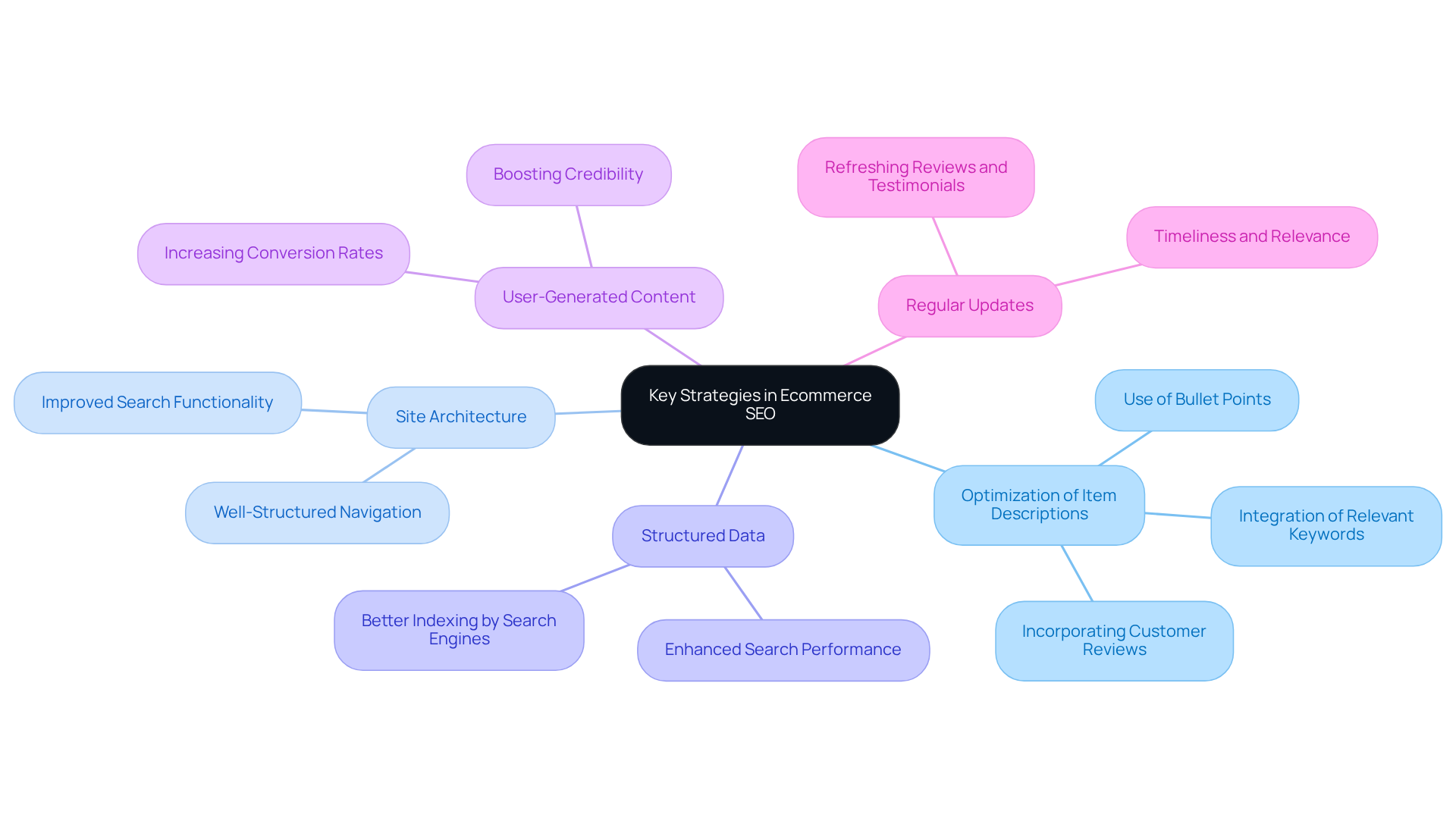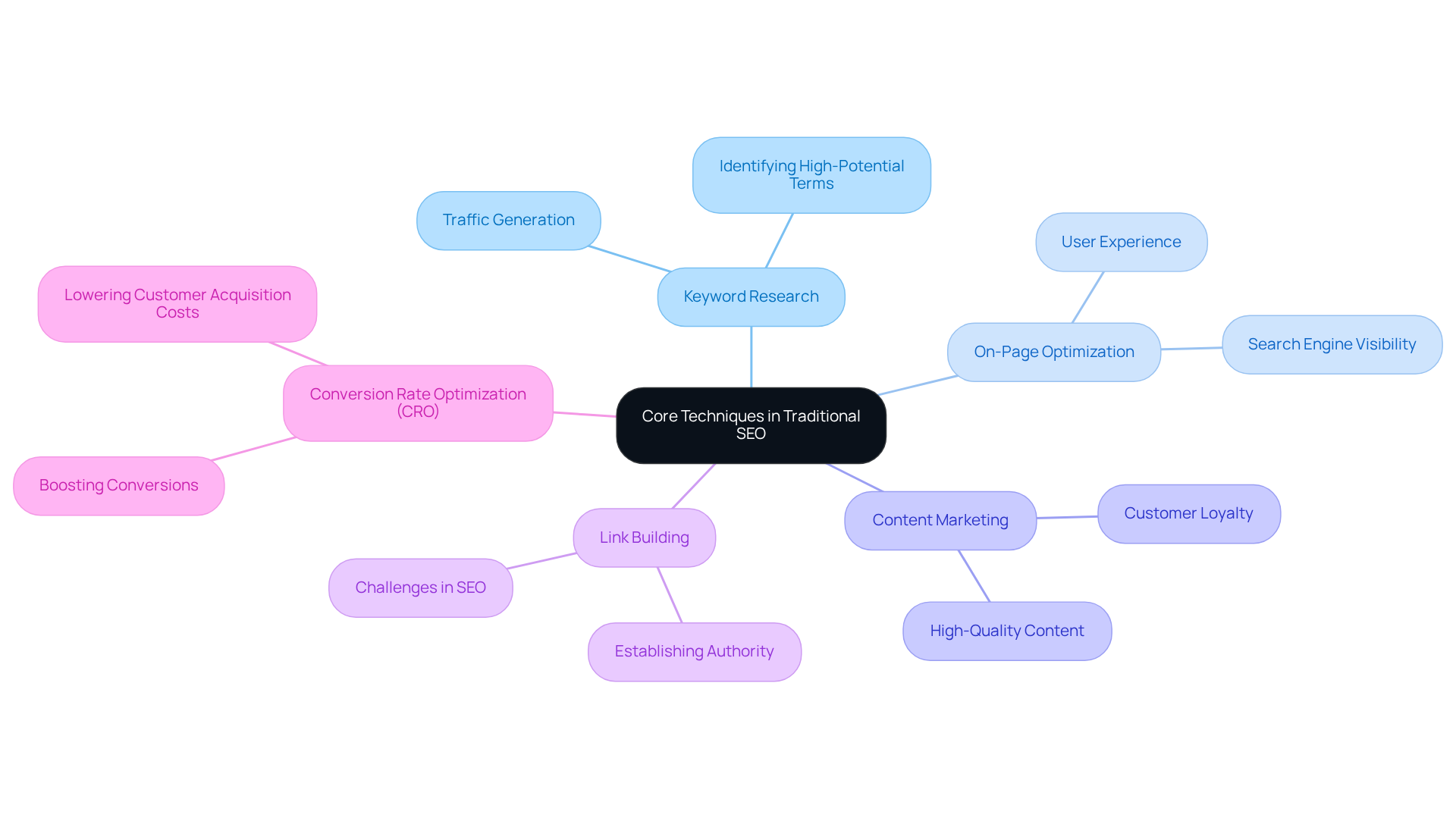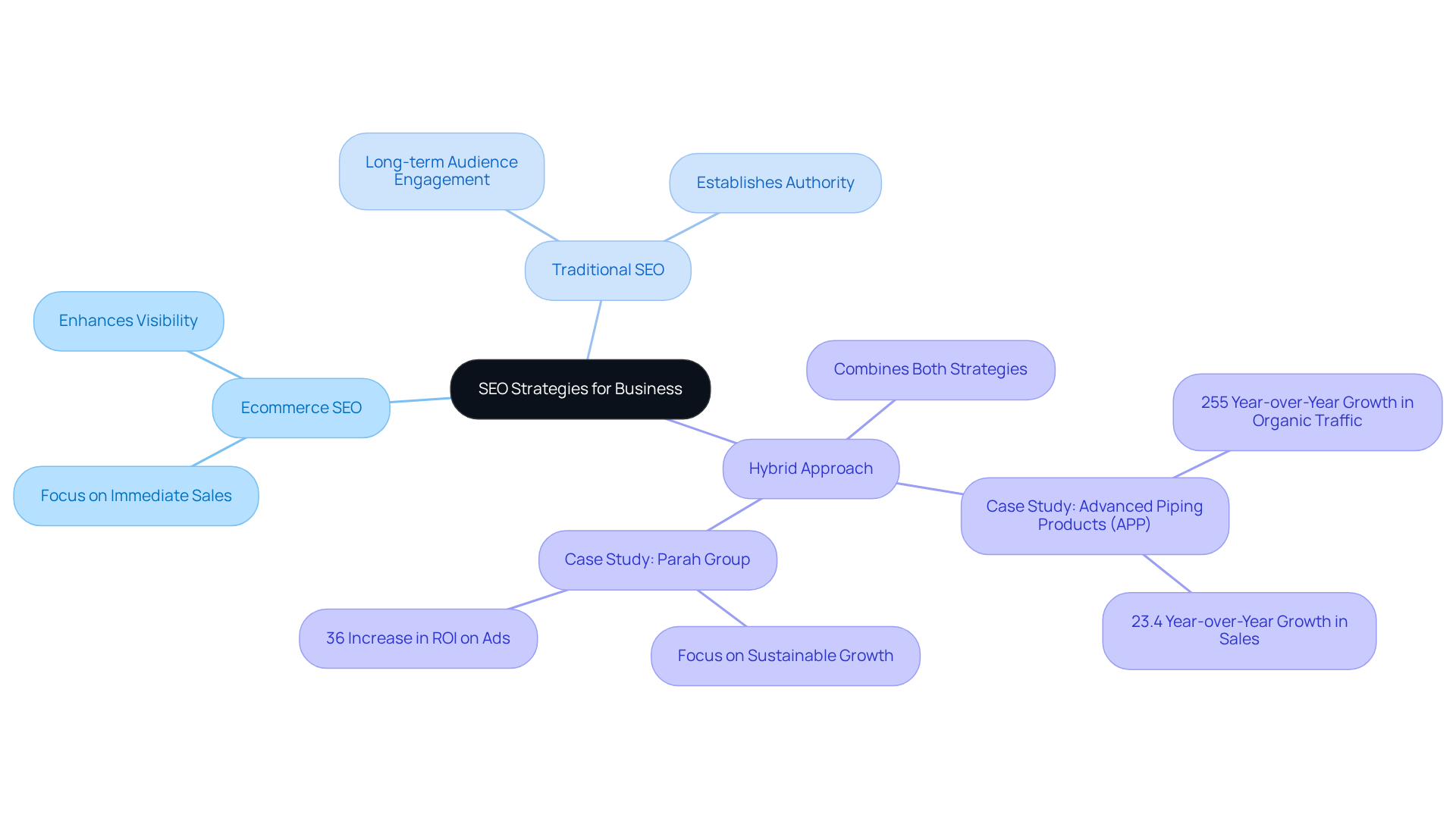
Overview
Ecommerce SEO services are specifically designed to optimize online stores, enhancing visibility and driving sales through targeted strategies tailored for product detail pages and user experience. In contrast, traditional SEO encompasses a broader spectrum of websites, lacking a direct sales emphasis. This distinction is crucial: ecommerce SEO not only aims to improve conversion rates but also seeks to elevate average order values through specific tactics. Traditional SEO, on the other hand, prioritizes the development of long-term brand authority and the accumulation of organic traffic. Understanding these differences is essential for businesses aiming to leverage the full potential of their online presence.
Introduction
The digital marketplace is evolving at an unprecedented pace, compelling businesses to enhance their online presence to stand out decisively. Understanding the critical differences between Ecommerce SEO and Traditional SEO is essential for brands aiming to optimize their strategies for maximum impact.
While both approaches seek to increase visibility and drive traffic, they cater to distinct objectives:
- Ecommerce SEO focuses on immediate sales conversions.
- Traditional SEO builds long-term authority.
In this crowded online landscape, how can businesses navigate these distinct paths to ensure they are not only seen but also chosen by consumers?
Understanding Ecommerce SEO vs. Traditional SEO
The seo service for ecommerce is a specialized discipline focused on optimizing online stores to enhance visibility and drive sales through search engines. It incorporates tailored strategies for item detail pages (PDPs), category pages, and user experience, all aimed at improving conversion rates. Recent trends underscore the importance of optimizing PDPs for indexability and ensuring unique, descriptive content, which is essential for competing effectively in the rapidly evolving ecommerce landscape. In contrast, Traditional SEO encompasses a broader spectrum of websites, including blogs and informational sites, with the goal of improving overall search engine rankings without a direct emphasis on sales. While both disciplines aim to increase organic traffic, the seo service for ecommerce is distinctly targeted toward and maximizing average order values (AOV).
As search engine results pages (SERPs) evolve, brands must adapt their strategies to maintain visibility and drive traffic. The rise of zero-click searches, which have seen a slight increase across most 15 US merchandise categories year-over-year, along with the growing prominence of features like images and reviews on mobile SERPs, highlights the necessity for ecommerce sites to prioritize these elements in their optimization efforts.
Furthermore, integrating structured data with product feeds is crucial for enhancing visibility in search results, and ensuring structured data parity with the merchant center feed is vital for this purpose. Producing top-of-the-funnel content can effectively build authority and attract valuable backlinks. As the landscape continues to shift, brands that leverage AI for SEO activities are gaining a competitive edge, with 27% of SEOs expressing uncertainty about the impact of AI Overviews in Ecommerce. This emphasizes the significance of adopting innovative approaches to stay ahead in the market. Ultimately, the distinction between Ecommerce SEO and Traditional SEO lies in the former's targeted approach to driving sales and enhancing conversion rates, making seo service for ecommerce an essential component for online retailers aiming for sustainable growth.

Key Strategies in Ecommerce SEO
Key strategies in the seo service for ecommerce start with the optimization of item descriptions through the integration of relevant keywords, which is crucial for enhancing search visibility. A well-structured site architecture is equally important, as it facilitates better navigation for users. Furthermore, the implementation of structured data plays a pivotal role in improving search performance. , such as reviews and ratings, should not be overlooked; it significantly boosts credibility and conversion rates. By incorporating customer reviews and testimonials into item descriptions, businesses not only enrich the content but also establish trust with prospective clients.
Regularly revising item descriptions is essential to ensure their timeliness and relevance, which in turn guarantees sustained SEO efficiency. Moreover, utilizing bullet points in product descriptions enhances readability and effectively highlights key features, making the information more accessible to potential buyers. These strategies are designed to create a seamless shopping experience that encourages purchases, setting them apart from traditional SEO service for ecommerce, which often prioritizes content generation and backlink development without a direct sales focus.

Core Techniques in Traditional SEO
Core techniques in Traditional SEO encompass keyword research, on-page optimization, content marketing, and link building, all designed to enhance a website's authority and relevance in search engine results. Effective keyword research identifies high-potential terms that drive traffic, while on-page optimization ensures that content is structured for both user experience and search engine visibility. Content marketing plays a pivotal role; businesses prioritizing high-quality content can significantly increase their organic traffic.
However, while these approaches effectively draw in visitors, they may not consistently result in prompt sales, especially for direct-to-consumer (DTC) companies emphasizing swift conversions. For instance, conversion rates for health and beauty online shopping are 2.7%, while luxury handbags are at 0.4%, illustrating the varying effectiveness across sectors. A focus on producing valuable content can improve engagement and foster customer loyalty, yet it may not directly convert to sales, particularly in a competitive environment where immediate results are essential.
This is where Parah Group's expertise in Conversion Rate Optimization (CRO) becomes essential. Parah Group distinguishes itself by emphasizing profitability and sustainable growth, utilizing data-driven approaches that concentrate on boosting conversions, thus assisting DTC companies in lowering customer acquisition expenses and improving profitability. The onboarding process includes an immediate call with a CRO lead to establish a foundation for long-term growth, ensuring a tailored approach to each client's needs.
Link building remains a vital aspect of Traditional SEO, with experts noting that '41% of marketers view link building as the most challenging aspect of SEO,' underscoring its importance in establishing authority. Additionally, mobile optimization is crucial, as mobile now accounts for 63.31% of all web traffic. Thus, although Traditional SEO techniques are vital for creating a robust online presence, DTC brands must also consider like CRO that enhance conversions alongside traffic.

Comparative Effectiveness: Ecommerce SEO vs. Traditional SEO
The distinctly showcases higher conversion rates due to its targeted strategies aimed at enhancing sales. For instance, optimizing product pages, integrating gamified progress indicators for free shipping thresholds, and implementing post-purchase upsells can drive immediate purchases.
Parah Group's case studies underscore this assertion:
- A $30M apparel company saw a 35% increase in conversion rates after employing focused CRO techniques, such as refined product pricing and reduced pop-ups.
- A $15M cleaning product company achieved a remarkable 73% boost in average order value through analogous improvements, including the introduction of bundles and multi-packs.
In contrast, Traditional SEO fosters long-term brand authority and organic traffic, which can be beneficial for businesses striving to cultivate a robust online presence. Ultimately, the decision between these two approaches hinges on the business's short-term goals and long-term strategy. However, the compelling results from Parah Group's innovative techniques highlight the significant potential for revenue enhancement and profitability improvement for DTC companies when they implement seo service for ecommerce.

Choosing the Right SEO Strategy for Your Business
Choosing the appropriate SEO strategy requires a thorough evaluation of your business objectives, target audience, and product offerings. For companies aiming to drive immediate sales and enhance conversion rates, an SEO service for ecommerce often emerges as the most effective tactic. This strategy is designed to elevate visibility in search results, thereby directly influencing sales performance. Conversely, if the objective is to establish authority and engage a broader audience over time, Traditional SEO may prove to be more fitting.
However, the most successful brands recognize the value of integrating both ecommerce and traditional SEO strategies with an effective SEO service for ecommerce. This hybrid approach not only maximizes online visibility but also cultivates sustainable growth. For example, Advanced Piping Products (APP) achieved an impressive 255% year-over-year growth in organic traffic following the implementation of a comprehensive marketing plan that encompassed both SEO strategies. As we approach 2025, companies should assess their specific goals and consider how a dual approach can enhance their overall marketing efforts.
As emphasized by industry experts, the combination of these methodologies allows companies to harness the benefits of each, creating a comprehensive SEO strategy that addresses both short-term sales needs and long-term business growth. This alignment is essential for navigating the through an effective SEO service for ecommerce. Furthermore, Parah Group underscores the significance of sustainable growth and long-term profitability, making their SEO approach particularly pertinent for brands seeking to optimize their resources effectively.

Conclusion
The distinction between ecommerce SEO services and traditional SEO services is essential for businesses striving to optimize their online presence effectively. Ecommerce SEO is specifically designed to enhance visibility and drive sales for online stores, employing targeted strategies that focus on product pages and user experience to maximize conversion rates. In contrast, traditional SEO encompasses a broader range of websites, prioritizing overall search engine rankings without a direct emphasis on immediate sales.
Key insights from the article underscore the necessity of optimizing item detail pages and utilizing structured data to improve search performance. Strategies such as integrating user-generated content and regularly updating product descriptions are vital for ecommerce success. Meanwhile, traditional SEO techniques, including keyword research and content marketing, are crucial for building brand authority over time. The comparative effectiveness of these approaches highlights that ecommerce SEO can yield higher conversion rates, making it a critical component for retailers focused on driving sales.
Ultimately, businesses must carefully evaluate their goals and consider a hybrid approach that amalgamates both ecommerce and traditional SEO strategies. This comprehensive tactic not only enhances visibility but also fosters sustainable growth in the competitive online retail landscape. As the market continues to evolve, leveraging the strengths of both methodologies will empower brands to navigate challenges and seize opportunities in their quest for long-term profitability.
Frequently Asked Questions
What is Ecommerce SEO?
Ecommerce SEO is a specialized discipline focused on optimizing online stores to improve visibility and drive sales through search engines. It includes tailored strategies for item detail pages, category pages, and user experience to enhance conversion rates.
How does Ecommerce SEO differ from Traditional SEO?
Ecommerce SEO is specifically targeted toward driving conversions and maximizing average order values, while Traditional SEO encompasses a broader range of websites, including blogs and informational sites, with a focus on improving overall search engine rankings without a direct sales emphasis.
What recent trends are impacting Ecommerce SEO?
Recent trends include the rise of zero-click searches and the growing prominence of images and reviews on mobile search engine results pages (SERPs). Ecommerce sites must prioritize these elements in their optimization efforts to maintain visibility and drive traffic.
Why is structured data important in Ecommerce SEO?
Integrating structured data with product feeds is crucial for enhancing visibility in search results. It ensures that the structured data aligns with the merchant center feed, which is vital for effective optimization.
How can user-generated content impact Ecommerce SEO?
User-generated content, such as reviews and ratings, boosts credibility and conversion rates. Incorporating customer reviews and testimonials into item descriptions enriches content and establishes trust with potential clients.
What are key strategies for optimizing item descriptions in Ecommerce SEO?
Key strategies include integrating relevant keywords, maintaining a well-structured site architecture, regularly revising item descriptions for timeliness, and using bullet points to enhance readability and highlight key features.
How can businesses build authority in Ecommerce SEO?
Producing top-of-the-funnel content can effectively build authority and attract valuable backlinks, which are important for improving search visibility and driving traffic.
What role does AI play in Ecommerce SEO?
Brands leveraging AI for SEO activities are gaining a competitive edge, as it helps in adapting to the evolving landscape. However, many SEOs express uncertainty about the impact of AI in Ecommerce.
Why is regular revision of item descriptions important?
Regularly revising item descriptions ensures their timeliness and relevance, which is essential for maintaining sustained SEO efficiency and improving conversion rates.
FAQs











